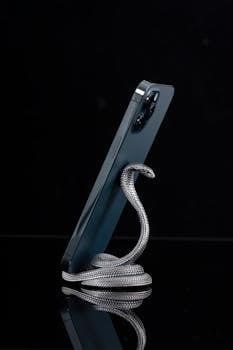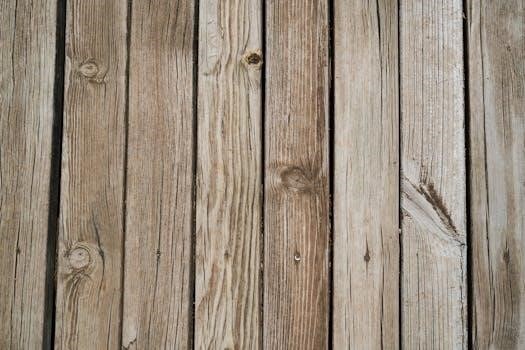Cobra Knot Instructions PDF⁚ A Comprehensive Guide
Unlock the art of paracord crafting with our comprehensive guide to the Cobra Knot! Whether you’re a beginner or a seasoned crafter, this resource provides easy-to-follow instructions in PDF format. Learn to create bracelets, lanyards, and more with this versatile knot.
The Cobra Knot, also known as the Solomon Bar or Portuguese Sinnet, is a fundamental knot in paracord crafting. Its popularity stems from its ease of learning and the visually appealing, textured pattern it creates. This knot is commonly used to create durable and stylish items such as bracelets, lanyards, keychains, and even dog leashes. The Cobra Knot’s strength and versatility make it an excellent choice for both practical and decorative purposes.
Originating from its use in survival situations where strong and reliable cords are essential, the Cobra Knot offers a secure and robust weave. The interwoven structure of the knot provides considerable strength, making it suitable for applications requiring a dependable hold. Whether you’re securing gear, creating a fashion accessory, or engaging in a DIY project, the Cobra Knot’s reliability is unmatched.
This guide will walk you through the basics of tying the Cobra Knot, its variations, and its many applications. By mastering this knot, you’ll open up a world of possibilities for crafting unique and functional items. Let’s dive into the fascinating world of the Cobra Knot and discover how to bring your creative visions to life!
Materials and Tools Needed for Cobra Knot Projects
Before embarking on your Cobra Knot project, gathering the necessary materials and tools is crucial for a smooth and successful crafting experience. The primary material, of course, is paracord. 550 paracord is a popular choice due to its strength and durability, available in a wide array of colors and patterns to suit your aesthetic preferences. The amount of paracord needed will vary depending on the project; bracelets typically require 8-10 feet, while larger projects may need significantly more.
In addition to paracord, a few essential tools will aid in the knot-tying process. A pair of scissors or a sharp knife is necessary for cutting the paracord to the desired length and trimming any excess. A lighter is useful for melting the ends of the paracord to prevent fraying, ensuring a clean and professional finish. For certain projects, a jig or a buckle can be helpful in maintaining consistent tension and creating a more uniform weave.
Optional but highly recommended tools include a fid or needle for weaving the paracord ends neatly into the finished project, and pliers for gripping and manipulating the cord. With these materials and tools at hand, you’ll be well-equipped to create a wide range of Cobra Knot projects with ease and precision.
Measuring and Preparing Paracord
Accurate measurement and proper preparation of your paracord are fundamental steps in any Cobra Knot project. The length of paracord required depends heavily on the project’s complexity and desired size. For a basic Cobra Knot bracelet, a general guideline is to use approximately 1 foot of paracord for every inch of wrist circumference. However, it’s always wise to overestimate slightly, as it’s easier to trim excess cord than to come up short.
To measure your wrist accurately, use a flexible measuring tape or a piece of string that you can then measure against a ruler. Add a few extra inches to account for the knotting process and any desired overlap. Once you’ve determined the necessary length, carefully cut the paracord using sharp scissors or a knife. To prevent fraying, it’s essential to seal the ends of the paracord immediately after cutting.
This can be done by carefully melting the ends with a lighter or a heat source. Hold the flame close to the end of the cord until it begins to melt, then gently roll the melted end against a non-flammable surface to create a smooth, sealed finish. This prevents the individual strands from unraveling and ensures a clean, professional look for your finished Cobra Knot project. Remember to exercise caution when working with heat and ensure proper ventilation.
Basic Cobra Knot Tying Steps
Mastering the basic Cobra Knot is essential for creating various paracord projects. Begin by establishing a secure base. This is typically done by creating a loop or attaching the paracord to a buckle, depending on the project. Once the base is secure, you’ll have two working ends of the paracord. Take the right strand and cross it over the two center strands, forming a ‘P’ shape. Then, bring the left strand over the right strand, under the center strands, and up through the ‘P’ loop you created.
Pull both ends tight to form the first knot; This completes one half of the Cobra Knot. For the next knot, reverse the process. Take the left strand and cross it over the two center strands, forming a reversed ‘P’ shape. Bring the right strand over the left strand, under the center strands, and up through the reversed ‘P’ loop. Again, pull both ends tight to secure the knot.
Repeat these steps, alternating the sides from which you start each knot, to create the Cobra weave. Consistent tension is key to achieving a uniform and aesthetically pleasing result. As you progress, you’ll notice the Cobra pattern forming, creating a sturdy and visually appealing braid. With practice, these basic steps will become second nature, allowing you to tackle more complex Cobra Knot projects with confidence.
The Cobra Weave/Solomon Bar Variation
The Cobra Weave, also known as the Solomon Bar, is a fundamental variation built upon the basic Cobra Knot. While the core technique remains the same – alternating knots tied around a central strand – the Solomon Bar often refers to a wider, flatter weave. This variation is commonly used for bracelets, lanyards, and other applications where a broader, more substantial cord is desired.
To create the Solomon Bar, maintain consistent tension and ensure that each knot is pulled snugly against the previous one. This will create a tight, uniform weave. The key to achieving the desired width lies in the initial length of the core strands and the tightness of the knots. Experiment with different lengths and tensions to find the perfect balance for your project.
The Solomon Bar’s robust nature makes it ideal for items requiring durability and strength. Its distinctive appearance adds a touch of rugged style to any paracord creation. Whether you’re crafting a survival bracelet or a decorative keychain, the Cobra Weave/Solomon Bar variation offers a versatile and visually appealing option. Mastering this technique opens up a world of possibilities for your paracord projects, allowing you to create functional and fashionable items with ease.
Two-Color Cobra Weave Technique
Elevate your Cobra Weave projects with the captivating Two-Color technique, adding depth and visual interest to your paracord creations. This method involves using two distinct colors of paracord, strategically interlacing them to create a striking pattern within the weave. The result is a dynamic design that showcases your craftsmanship and personal style.
To execute the Two-Color Cobra Weave, begin by attaching both colors to your buckle or starting point. Designate one color as your primary and the other as your secondary. As you tie the Cobra Knots, alternate the color that you bring over the core strands. For example, if you start with the primary color on the right, bring it over the core, then tie the knot. For the next knot, use the secondary color on the left, bringing it over the core and tying the knot.
Maintain a consistent pattern throughout the weave to achieve a uniform and aesthetically pleasing design. Experiment with different color combinations to create unique and personalized pieces. The Two-Color Cobra Weave is an excellent way to add a touch of flair to bracelets, lanyards, and other paracord projects. This technique not only enhances the visual appeal but also adds a layer of complexity and sophistication to your work.

Creating a Cobra Weave Paracord Bracelet
Embark on a rewarding crafting journey by creating your very own Cobra Weave Paracord Bracelet. This project is perfect for beginners and seasoned crafters alike, offering a blend of simplicity and customization. With just a few essential materials and a bit of patience, you can fashion a stylish and functional accessory.
Begin by measuring your wrist to determine the desired length of the bracelet. Add a few extra inches to account for the knotting process and the buckle. Secure the paracord to the buckle using a lark’s head knot, ensuring that both strands are of equal length. Now, begin the Cobra Weave by alternating the left and right strands over and under the core strands, creating a series of knots that form the distinctive Cobra pattern.
Maintain consistent tension throughout the weaving process to ensure a uniform and aesthetically pleasing bracelet. As you progress, periodically check the fit around your wrist to ensure the desired size. Once you reach the desired length, trim the excess paracord and carefully melt the ends to prevent fraying. Attach the other half of the buckle, and your Cobra Weave Paracord Bracelet is complete!
Making a Cobra Stitch Lanyard
Craft a practical and stylish Cobra Stitch Lanyard, perfect for securing keys, knives, multi-tools, or even your cell phone. This project utilizes the same fundamental Cobra weave technique as the bracelet, but adapts it for a longer, more versatile accessory. With just a few materials and some focused effort, you can create a durable and personalized lanyard.
Begin by determining the desired length of your lanyard. Account for both the woven portion and any additional length needed for attaching it to your desired items. Fold the paracord in half and create a loop at the folded end. This loop will serve as the attachment point for your keys or other items.
Start the Cobra stitch just below the loop, using the two strands of paracord to create the alternating over-under pattern. Maintain consistent tension to ensure a tight and uniform weave. As you work, periodically check the length and adjust your tension as needed. Once you reach the desired length, trim the excess paracord and carefully melt the ends to prevent fraying. For added security, consider adding a small knot at the end of the lanyard.
King Cobra Paracord Bracelet Tutorial
Elevate your paracord skills with the King Cobra Paracord Bracelet, an advanced version of the classic Cobra weave. This tutorial will guide you through the process of creating a wider, more substantial bracelet that showcases your knotting expertise. The King Cobra is essentially a Cobra weave layered on top of another Cobra weave, resulting in a visually striking and robust design.
First, create a standard Cobra weave bracelet as the base. Ensure the base bracelet fits comfortably around your wrist. Next, using a different color of paracord for added contrast, begin weaving a second Cobra weave directly over the first one. This second layer will follow the same alternating over-under pattern as the base, effectively doubling the thickness and width of the bracelet.
Pay close attention to maintaining consistent tension throughout the weaving process. This will ensure a uniform and professional-looking finish. Once you’ve completed the second layer, trim the excess paracord and carefully melt the ends to prevent fraying. The King Cobra Paracord Bracelet is a testament to your paracord mastery and a stylish addition to any collection.
Cobra Weave Drag Leash Instructions
Create a durable and reliable drag leash using the Cobra weave technique. This tutorial provides step-by-step instructions for crafting a leash suitable for animal handling, particularly in rescue or training scenarios. Drag leashes are designed to allow controlled movement while maintaining a secure connection.
Begin by measuring and preparing a sufficient length of paracord, typically a single continuous piece for enhanced strength. Attach a sturdy clip or carabiner to one end of the paracord, forming a secure loop. This will serve as the attachment point to the animal’s collar or harness. Next, start the Cobra weave just below the loop, following the alternating over-under pattern that characterizes the knot.
Continue the Cobra weave along the entire length of the leash, ensuring consistent tension and a tight weave for maximum durability. The Cobra weave’s inherent strength makes it ideal for this application, providing a secure and reliable connection. Once the desired length is achieved, finish the weave securely and trim the excess paracord. Melt the ends to prevent fraying and ensure a clean finish.
Finishing and Securing the Cobra Knot
Properly finishing and securing the Cobra knot is crucial for ensuring the longevity and safety of your paracord projects. After completing the weave, carefully trim any excess paracord, leaving about a quarter of an inch extending from the last knot. This allowance is essential for the next step⁚ melting the ends.

Using a lighter or heat source, gently melt the trimmed ends of the paracord. Be cautious not to burn the surrounding weave or yourself. As the paracord melts, use a non-flammable object, such as the side of metal scissors or pliers, to press the melted ends against the existing knot. This creates a secure bond, preventing the knot from unraveling over time.
For added security, especially in projects that will endure heavy use, consider incorporating additional measures. One option is to carefully sew the melted ends into the weave using a needle and thread. Another approach involves applying a small amount of strong adhesive to the melted ends before pressing them into the weave. These techniques provide an extra layer of protection, ensuring that your Cobra knot remains intact and reliable for years to come.
Applications of the Cobra Knot

The Cobra knot, also known as the Solomon Bar, boasts a remarkable versatility, making it a go-to choice for a wide array of applications. Its robust structure and ease of tying contribute to its popularity in both practical and decorative paracord projects.
One of the most common applications is creating paracord bracelets. These bracelets are not only stylish accessories but also serve as a readily available source of cordage in emergency situations. The Cobra knot’s inherent strength makes it ideal for crafting durable lanyards for keys, knives, and other essential tools, ensuring they remain securely attached.
Beyond personal accessories, the Cobra knot finds its place in outdoor and survival gear. It can be used to create sturdy straps for backpacks, handles for tools, and even emergency shelters. Its ability to be woven into wider mats and belts further expands its utility, providing comfortable and reliable support. Animal enthusiasts can utilize the Cobra weave to craft drag leashes, ensuring secure control while maintaining a stylish appearance.
From fashion to function, the Cobra knot’s adaptability ensures its continued relevance in the world of paracord crafting.
Resources for Paracord and Tools
Embarking on your Cobra knot journey requires the right materials and tools. Fortunately, a wealth of resources are available to equip you for success. High-quality paracord is paramount, ensuring both durability and aesthetic appeal for your projects. Online retailers like WestCoastParacord and TOUGH-GRID offer a wide selection of colors, patterns, and strengths to suit every need.
For tools, a basic set includes scissors or a sharp knife for cutting the paracord, a lighter or heat source for sealing the ends to prevent fraying, and a measuring tool for accurate sizing. Optional tools like a jig or marlinspike can aid in creating consistent and professional-looking knots, especially for larger projects.
Numerous online tutorials and communities provide invaluable guidance and inspiration. Websites like Instructables and YouTube channels dedicated to paracord crafting offer step-by-step instructions and creative ideas. Furthermore, local craft stores often carry paracord and tools, providing a hands-on shopping experience and expert advice.

With the right resources at your fingertips, you’ll be well-prepared to master the Cobra knot and unleash your creativity.